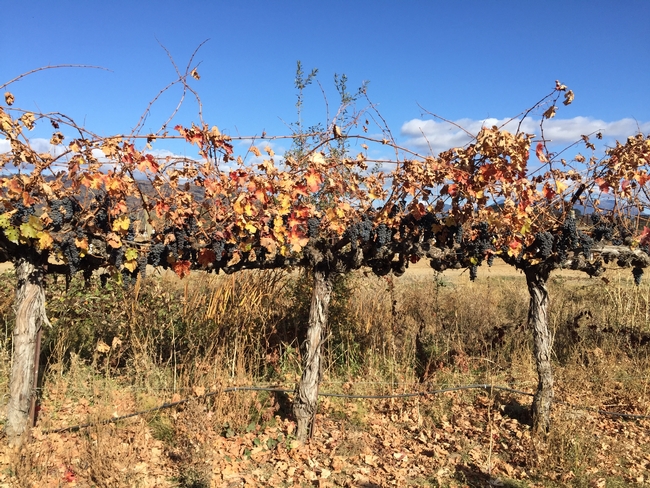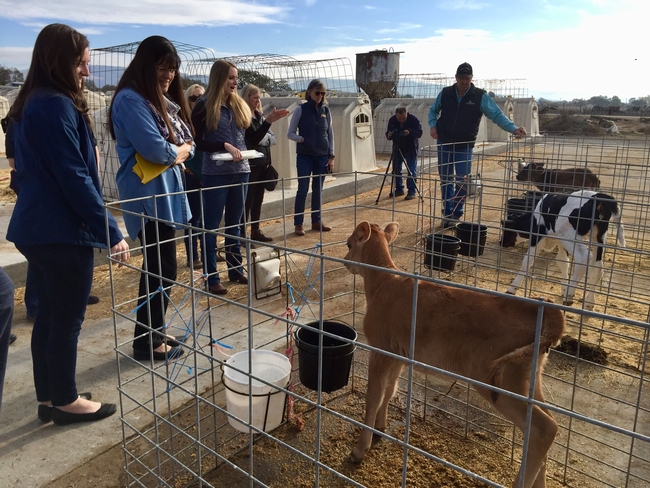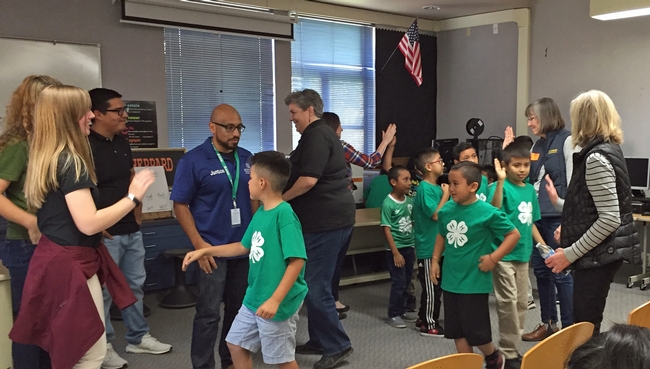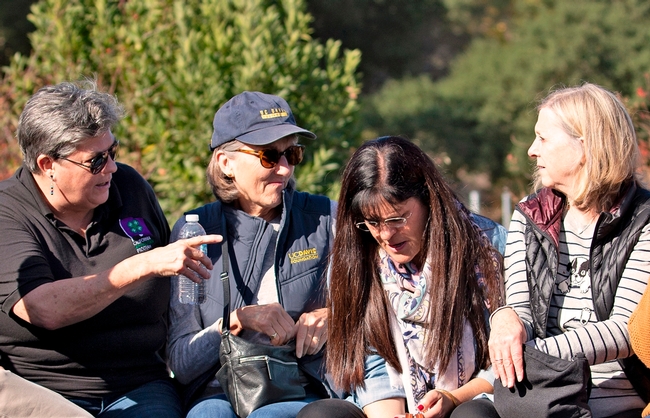- Author: Ella Griffith
- Author: Lindsey Jasperse
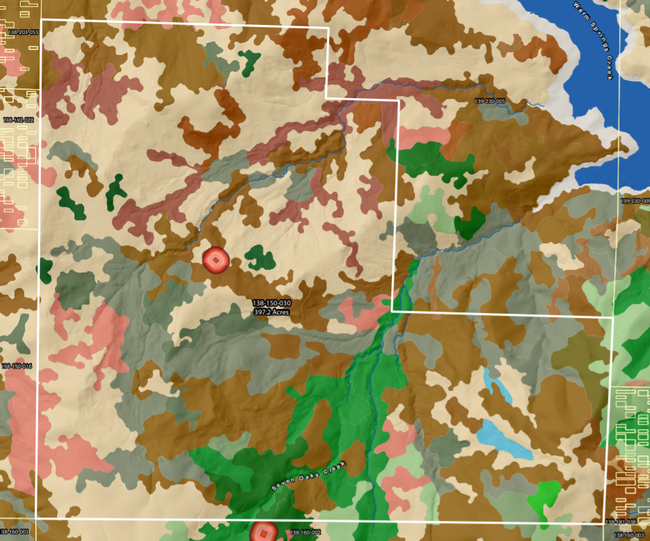
Fire in Sonoma County
Today's forests are less healthy and more prone to severe wildfires due to decades of fire suppression, lack of vegetation management, changing land use patterns, and extreme events such as drought. With vegetation build-up, compounded with dry landscapes and warmer temperatures, fire behavior has started to change resulting in more and larger high severity wildfires. Additionally, over 50% of the population in Sonoma County lives in the Wildlife Urban Interface, or WUI, meaning that the majority of our communities are dispersed amongst natural and forested areas and thus are at high risk for wildfire.
A Coordinated Approach to Managing Fuels
Successful management requires collaboration between public and private stakeholders to mitigate fire risk across the landscape. Thus far, Sonoma County has focused on defensible space and home hardening; critical practices; however, there are few tools to assist private landowners and managers in evaluating and deciphering fire hazards on a large landscape scale. Fuel management can appear complicated, is often expensive to implement, and planning an approach for reducing fuels requires detailed information about the landscape. With thousands of individual land parcels in Sonoma County, landowners need tools and resources to support them in reducing fuels and managing for future wildfires.
The Wildfire Fuel Mapper Toolkit
As wildfires increase in frequency and intensity, Sonoma County residents need to take steps to reduce fire risk across the region's diverse landscapes and communities to protect our people, our homes, and our natural resources. In order to do so, however, Sonoma County residents also need to be equipped with the necessary tools, resources, and information.
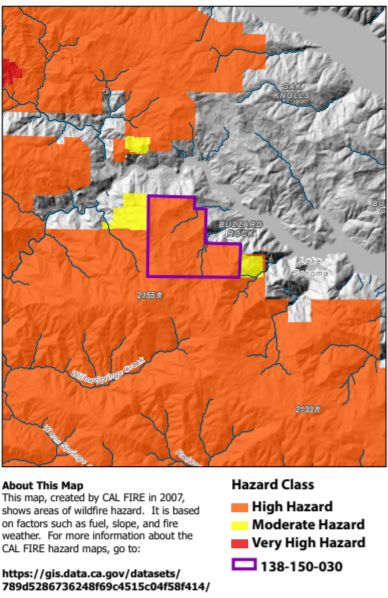
- Fire history
- Vegetation type and density
- Fuels such as fuel build-up
- CAL FIRE assessments of fire hazard level
- Slope and aspect
- Detailed aerial imagery
- Zoning and responsibility area designations
These maps can be used to achieve a number of different land management goals. They can help property owners assess fire hazards on their land and delineate management units. They can be used to create a vegetation management plan to improve forage quality and quantity available for livestock or wildlife. The map reports can be shared with professionals and specialists to get an overview of the property and understand the fire history of the parcel. They can even be used to highlight hazard severity and the need for treatment when applying to funding to supplement a fuel management plan.
In addition to providing detailed information about fuels and fire hazards on a landscape, the Wildfire Fuel Mapper provides several other resources. These resources are designed to help landowners understand how to use their map reports and start taking action, whether it be conducting a prescribed burn, implementing grazing, or creating a formal management plan. These tools and resources connect users with:
- Funding and cost-share opportunities
- Educational and technical resources to learn more
- Materials to support creating a management plan, individual parcels or in a watershed
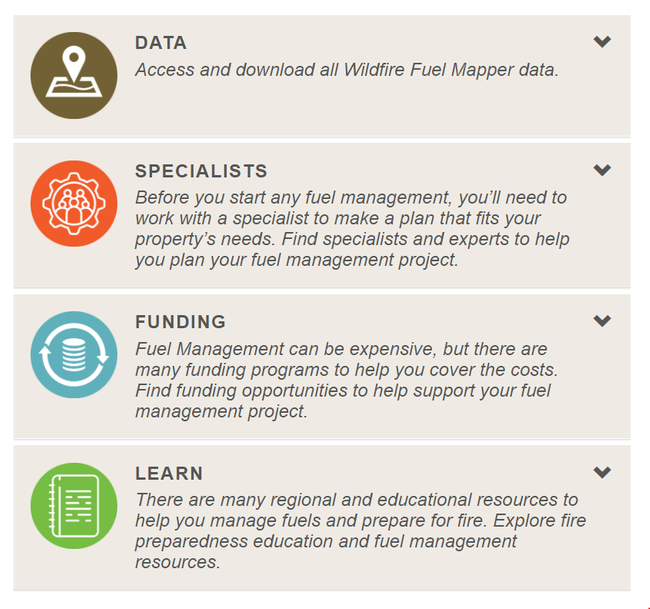
Wildfire Fuel Mapper Lake Sonoma Pilot Projects
The UCCE is currently testing the Wildfire Fuel Mapper in the Lake Sonoma watershed. We are conducting site visits with users to ground-truth the map reports and collecting feedback from both landowners and specialists throughout the region. Additionally, the UCCE is partnering with Circuit Rider to plan and implement 3-6 pilot projects using the Wildfire Fuel Mapper map reports. These pilot projects will be conducted by the Circuit Rider youth crews, and will demonstrate a variety of vegetation management strategies while promoting workforce development and professional skills for local youth.
Learn More & Get Started
As fires continue across Sonoma County, fuel management will be critical to protecting our communities now and in the future. The Wildfire Fuel Mapper provides landowners with the tools and resources needed to understand and begin managing fuels.
To learn more about the Wildfire Fuel Mapper, download your custom parcel or watershed report, and explore our interactive Story Map, visit: Wildfire Fuel Mapper. For further questions or to get involved, contact Dr. Stephanie Larson (slarson@ucanr.edu).
This project is a collaboration between University of California Cooperative Extension (UCCE), Pepperwood and Tukman Geospatial, with support from PG&E, the Thornton Foundation, and CAL FIRE.
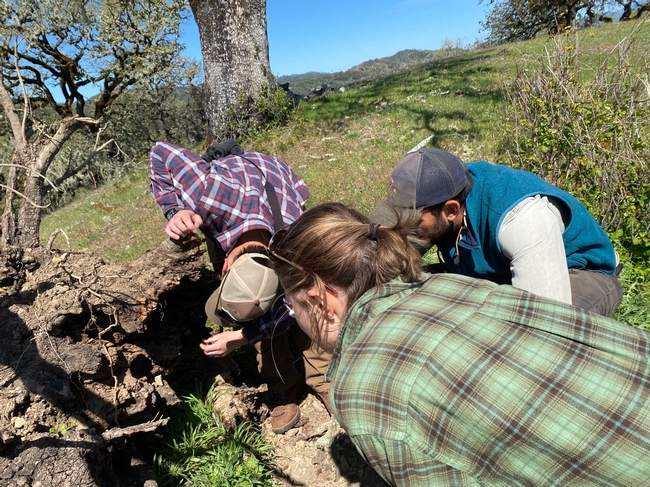
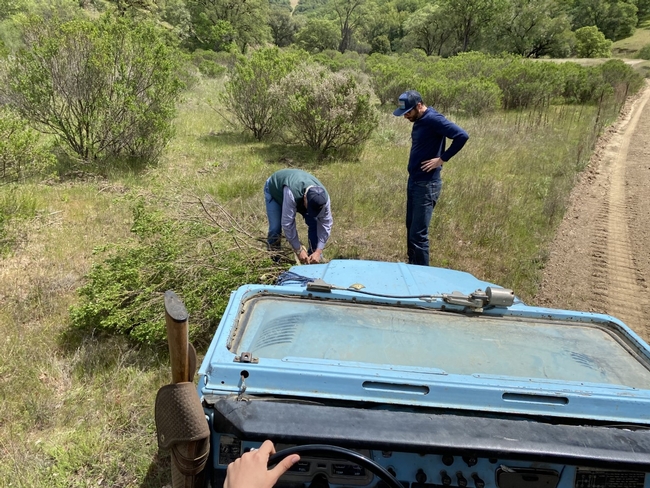
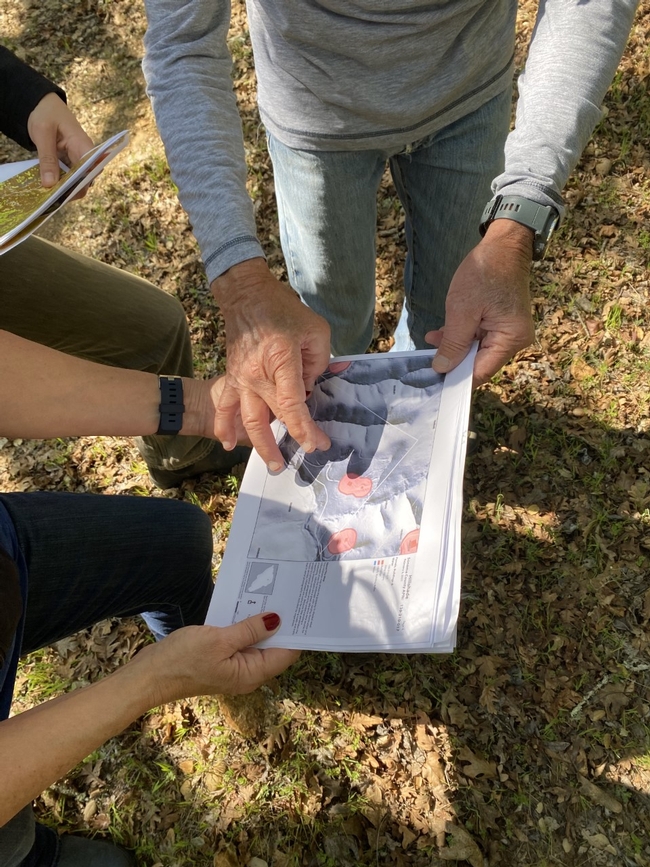
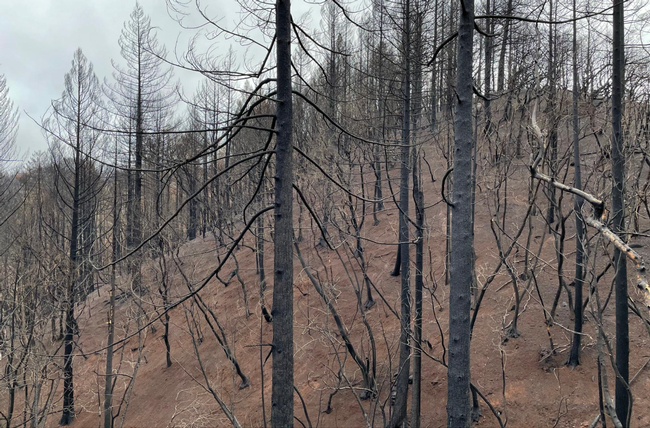
- Author: Michael I Jones
by Michael I. Jones, PhD, UCCE Forest Advisor, Mendocino, Lake, & Sonoma County
As someone who has studied forest health for a while, I have developed the rather unfortunate habit of noticing only the red and brown canopies that appear in a sea of green (my wife says it makes visiting the forest with me rather depressing). Unfortunately, the tell-tale sign that a tree just died has become a common sight in the coastal forests over the past few years. While there is a suite of forest health issues (invasive species, fire suppression, and climate change to name a few) that are likely driving this decline and dieback, there is one that I am currently most concerned about: Drought.
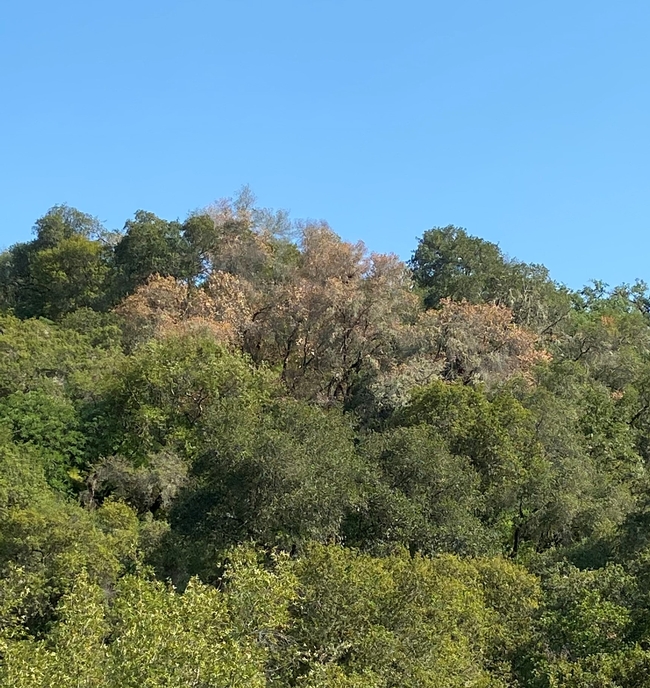
I noticed the first signs that drought stress was becoming an issue in early spring, when ponderosa pine began to die in eastern Mendocino County. Upon investigation, I found extensive western bark beetle and red turpentine beetle activity. I suspect the insects had established in fire stressed trees and their populations had built up over the past few years, to the point where they were spreading to trees that had no or little fire damage and into areas where there had not yet been wildfire. My colleagues and I have now observed ponderosa pine morality from northern Mendocino to northern Napa. It would seem we are at the initial stages of a western pine beetle outbreak, and I would suspect we will see a significant increase in pine mortality throughout the summer and into the next year.
Another conifer I have been getting questions about recently is Douglas-fir. Over the past few years there has been noticeable Douglas-fir decline and mortality, especially in young trees that have encroached into oak woodlands and rangeland. While this is an indication of unhealthy forests and stressed trees, I do not necessarily see this as a serious forest health issue since the expansion and growth of Douglas-fir in high densities into other habitats is the result of forest succession in the absence of fire. So, in my opinion the decline of some of these trees is a natural process resulting from the stress of growing on low quality sites and competing for water and nutrients, resulting in insect and disease infestations. Drought further increasing water stress and accelerates the rate of decline and dieback. However, I have yet to see extensive Douglas-fir mortality in high quality sites such as north facing slopes with moist, mild climates.
The next significant sign that drought stress was becoming an issue was the decline and mortality of interior live oak and CA Black oak in southern Mendocino County (Hopland). Upon investigating several clusters of declining trees, I found that the mortality was not associated with sudden oak death, but instead appeared to be caused by outbreaks of western oak bark beetle, a native bark beetle that is attracted to stressed trees. While many of the declining trees have extensive evidence of the bark beetle activity, several trees have only a few galleries, but were covered in cankers which are indicative of foamy bark canker, a disease caused by a pathogen the bark beetle vectors. While I have only observed this decline in the Hopland area, western oak bark beetle is found throughout California and could easily outbreak in other areas where oaks are highly drought stressed. Additionally, other native oak pests such as twig blight, branch canker, pit scale and invasive pests such as sudden oak death and Mediterranean oak borer are becoming more common in drought stressed trees throughout the Coastal Range.
What can we do about forest health and the drought? Many of the pests I mentioned are native and are simply acting as natural disturbances that help cull stressed and dying trees and begin the process of nutrient cycling. While eradicating pests or preventing them from infesting trees is extremely difficult, their populations can be controlled by pruning or removing and destroying heavily infested material. Suppressing insect and disease populations will not prevent all tree mortality but can help mitigate outbreaks that could spread to relatively healthy trees.
Thinning is another way to help the forest gain resiliency to drought. It can improve tree vigor through the reduction of competition and increase access to water and nutrients. But, when thinning is not an option, such as in an oak woodland or savannah and trees are still showing drought stress, then hopefully the drought adaptations these trees have evolved will be enough to help them survive.
For more information check out the UCCE Mendocino – Forest Health webpage at cemendocino.ucanr.edu. Also, feel free to contact me if you have questions, mjones@ucanr.edu or (707) 463-4495.
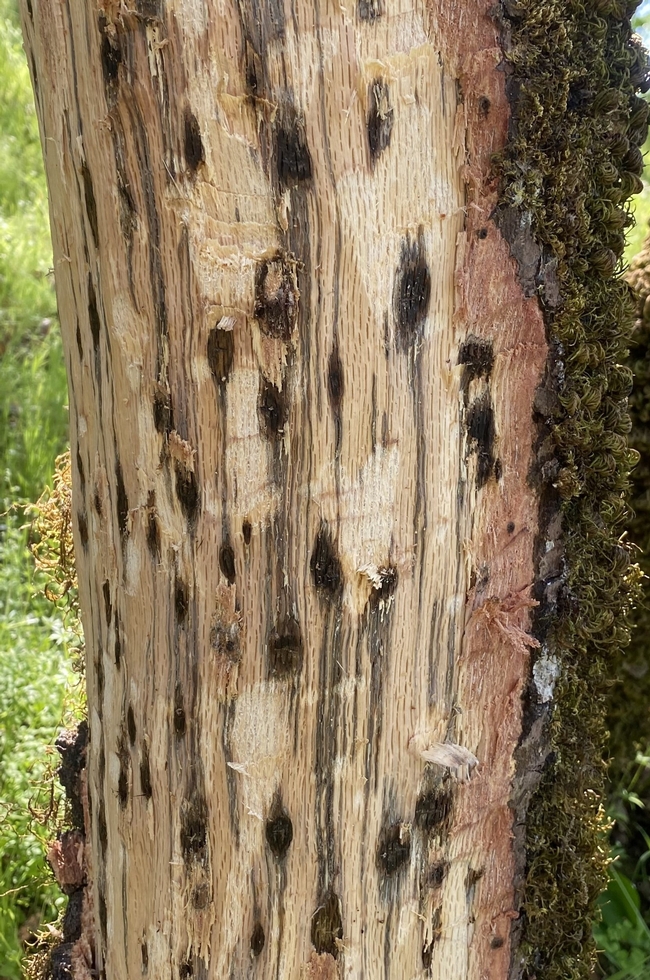
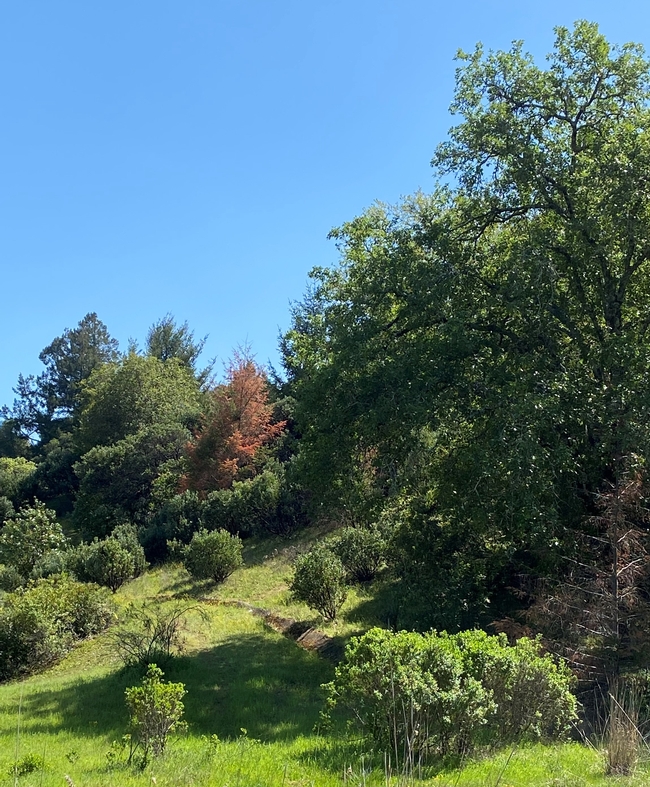
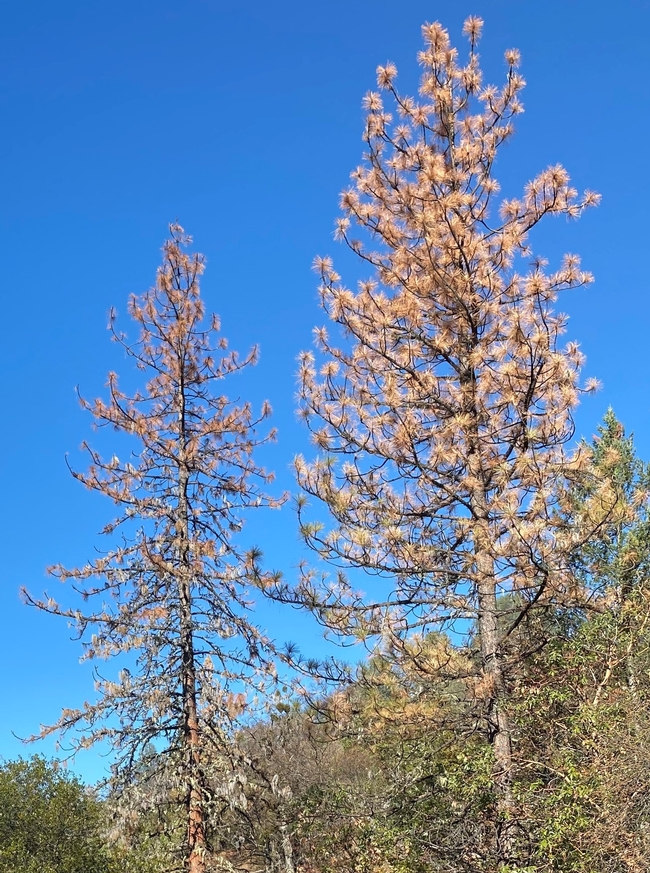
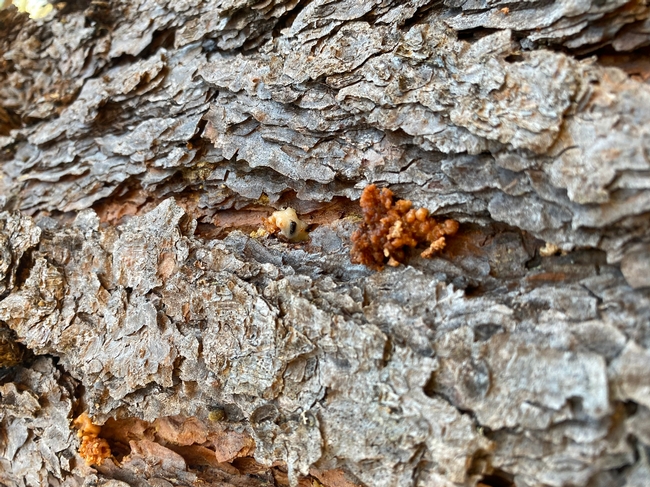
- Author: Stephanie Larson
- Contributor: Karen Giovannini
Here is a summary of some of the work our office is doing during shelter in place.
Fire & Resiliency
UCCE Sonoma is building on the foundational work of other county departments such as Sonoma Water and Permit Sonoma, by providing outreach to private landowners to address forest health, vegetation management and fire fuel reduction.
Lake Sonoma Decision Support System: Development of an online geo spatial reporting tool to help landowners assess:
Match.Graze: development of an online database that connects land owners and grazers.
- Filmed educational videos
- Creating website
- Current status: roll out in early June.
Good Fire Alliance: partnership with Audubon Canyon Ranch to assist landowners in managing fire fuels through prescribed burning on private and publicly owned lands. The following prescribed fires are in the active planning stage: 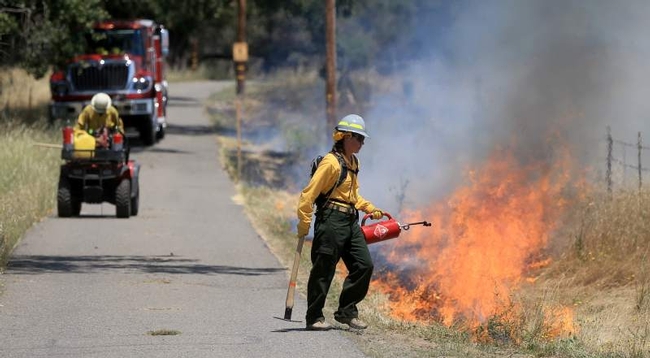
- 100+ acre burn unit at Cooley Ranch near Lake Sonoma; late May.
- Sonoma Ecology Center is planning a burn at Van Hoosear Wildflower Preserve; late May - early June.
- Bodega Pastures spanning several weekends in October/November.
Resilient Landscapes: Master Gardener collaborative project to:
- Host Firewise webinars
- Develop materials for Fire Safe Sonoma's Living with Fire brochure and webpage resource.
- Post Fire Survival/Mortality: research project to develop a quick and simple post-fire tree survival reference tool to aid with triage of burned landscapes.
- Working with local fire departments to homogenize fire-resilient landscape standards.
Oak Tree Health: organized, hosted and presented:
- California Oak Workshop with science based oak health information. Over 500 participants.
- Sudden Oak Death Blitz pivoted to online, educating and distributing 93 test kits to the public.
Food Systems & Security
Master Gardeners: 

- “Stay Home Grow Food” series has reached over 350 people with videos plus resources via an extensive social media campaign.
- Gardener Sense program delivered by video conference to help homeowners reduce water use.
- Master Gardener's are pivoting their classes to webinars.
Food Distribution
The value of a strong, connected local food system to sustain the resiliency of our communities has never been more clear.
Coordinating with Sonoma County Food System Alliance and strategizing for a series of video conferences on longer term emergency food response planning & strengthening the local food supply chain looking to local production & distribution as part of meeting food need.
- Meeting on March 23 with over 50 emergency food responders to strategize on coronavirus response.
- Chairing the Community Organizations Active in Disaster (COAD) Food group. Continue to collaborate with the group to meet the needs of emergency food organizations.
- Sonoma County Food Recovery Coalition
UCCE used connections to secure donations of over 12,000 wine boxes to
Redwood Empire Food Bank for boxing and distributing food.
Local Meat Supplies: Mobile Slaughter Unit (MSU)
UCCE is working with local livestock producers in Marin/Sonoma to create a business plan for an MSU which can assist local livestock producers with a local, safe option for processing livestock.
- Applying for USDA grant to assist these producers to determine the functionality of keeping it in production.
- Will develop educational and management strategies to ensure economic security for small-scale livestock producers.
Integrated Pest Management
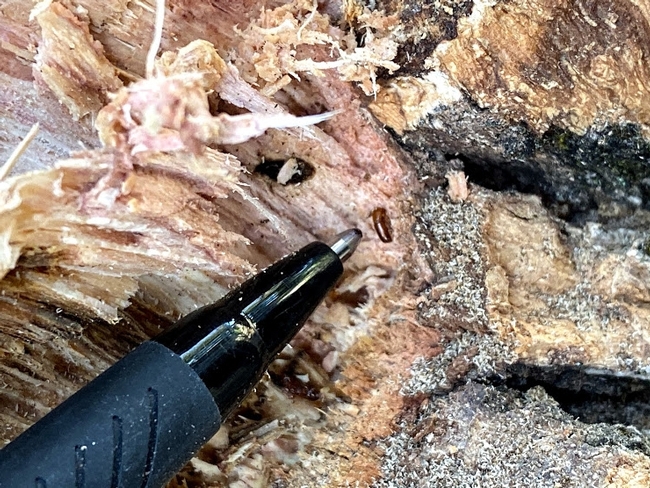
- Collaborating with UC Davis researchers to continue projects that address soil and fungal pests that shorten the lifespan of vineyards.
Critical research on the newly detected invasive Mediterranean oak borer (pictured) found in valley oak in eastern Sonoma County. Collaborators include Cal Fire, US Forest Service, and CDFA.
Youth
4-H youth educational programs have continued to engage youth and adults with online technologies.
- Developed fact sheets to support volunteer educators in delivering online programs available at Youth Development Resources
- Short-term educational programs have been implemented reaching elementary-aged children with science and art content.
- Ongoing programming has been transitioning online focused for teens around college and career readiness (Juntos 4-H) and youth participatory action research.
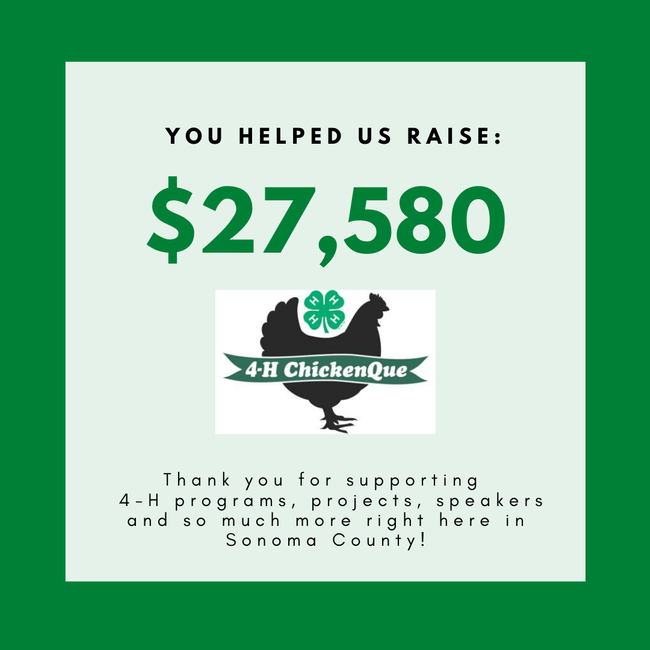
Annual Sonoma 4-H Open House and ChickenQue transitioned from a full-day chicken BBQ lunch fundraiser to a radiothon.
- Partnered with local radio The Bull 93.7 to do a radiothon.
- The station promoted 4-H with interviews of staff, volunteers, and youth.
- The event also served as a public awareness campaign showcasing the program's legacy helping youth reach their full potential.
Economic Viability
Climate Change
Working with local dairy and livestock producers to apply for grants from CDFA to reduce greenhouse gases:
- Alternative Manure Management Program
- Healthy Solis Program
If funded, these grants would bring over $5 million to reduce GHG by 4,154 MTeCO2
Support Local Producers
- Working with local creameries and FEED Sonoma, to develop a dairy CSA box option.
- Revisit the County Lands for Food Production program initiated by UCCE to increase the availability of county owned land to communities, farmers and ranchers.
- Find Local Food & Aid the Community
Outreach 

Providing information and updates.
Coronavirus Resources webpages provides information for agricultural enterprises focusing on financial resources, Ag worker safety and food safety and includes resources for where to find food from local farms and for opportunities to volunteer.
Subscribe to our monthly newsletter and alerts.
Follow our social media posts about coronavirus grant opportunities, resources, workshops and more on Twitter, Facebook and Instagram @UCCESonoma.
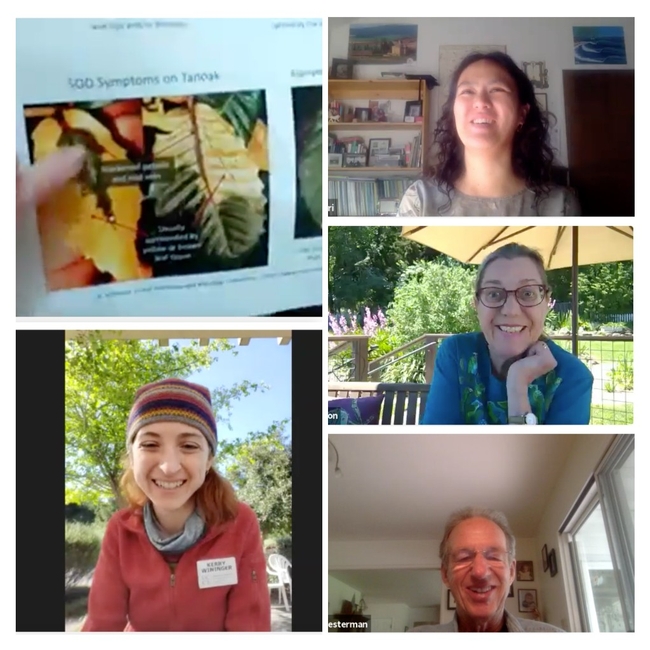
- Author: Karen Giovannini
We are pleased to share our 2019 Annual Report available in two formats! We have our print version and are excited to present our story map version!
Special thanks to Michelle Nozzari for putting together the story map version and Deborah Curle for the print version.

- Author: Pamela Kan-Rice
Vice President Glenda Humiston introduced alumni regent-designate Debby Stegura to UC Cooperative Extension staff and their community partners and clientele in Sonoma County on Nov. 15.
After visiting Beretta Dairy, Bayer Farm Park and Gardens, Sheppard Elementary and Stuhlmuller Vineyards, Regent Stegura tweeted:
“Blown away by @ucanr tour of @UCCESonoma work—Beretta Dairy, @UCMasterGarden, @Stuhlmullerwine, @California4H. Saw #kincaidfire reach, how to prepare better for future fires. @ucanr work benefits all of CA. Thank you!”
The retired business litigator and UC Davis alumna was joined on the tour by Anne Shaw, secretary and chief of staff to the regents, and Michael Bedard, UC state government relations legislative director.
Stephanie Larson, UCCE director for Sonoma County, led the tour, which first visited Beretta Dairy.
“It's so nice to have a dairy advisor,” Sonoma County dairy farmer Doug Beretta said, crediting Randi Black, UC Cooperative Extension dairy advisor, with providing the technical assistance he needed to apply for a grant to reduce methane emissions.
Black, who joined UC ANR in 2017, helped four local dairies obtain grants totaling $2.5 million and said the projects propose to reduce emissions by 9,327 metric tons of CO2 equivalent over the next 5 years, which is comparable to removing 2,028 passenger vehicles from the road for a year.
Beretta talked about the work he has done at the dairy, based on UC research, to improve water quality. David Lewis, UCCE director for Marin and Napa counties, noted that similar manure management and water-quality work is being implemented by UCCE clientele in his counties.
Discussing the hardships created by low milk prices in the dairy industry, Beretta said he appreciated UCCE's agricultural ombudsman Karen Giovannini guiding producers who want to sell value-added products through the permitting process.
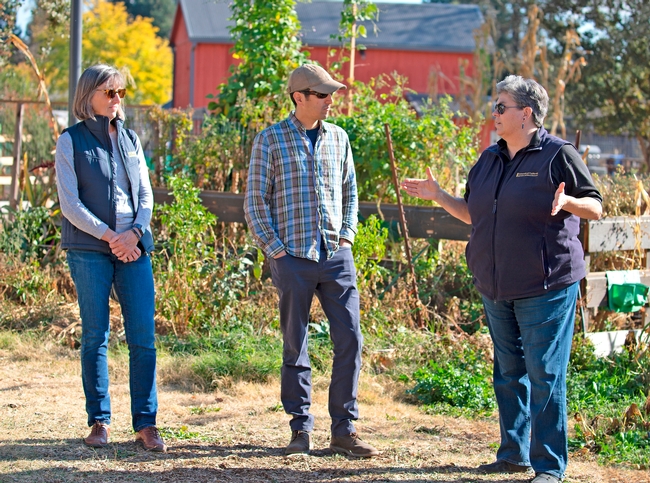
From the dairy, Stegura and the group met with Mimi Enright, UC Master Gardener Program manager for Sonoma County, UC Master Gardener volunteers and Julia Van Soelen Kim, North Bay food systems advisor at Bayer Farm Park and Gardens.
Collaborating with Bayer Farm, the Master Gardeners have been expanding outreach to Spanish-speaking members of the community. In addition to all of the traditional Master Gardener outreach, the Master Gardeners in Sonoma County have been actively promoting firewise landscaping to help Sonoma County residents better prepare for wildfires. Using UC ANR materials is critical, Enright said, to assure people the recommendations are based on scientific research. 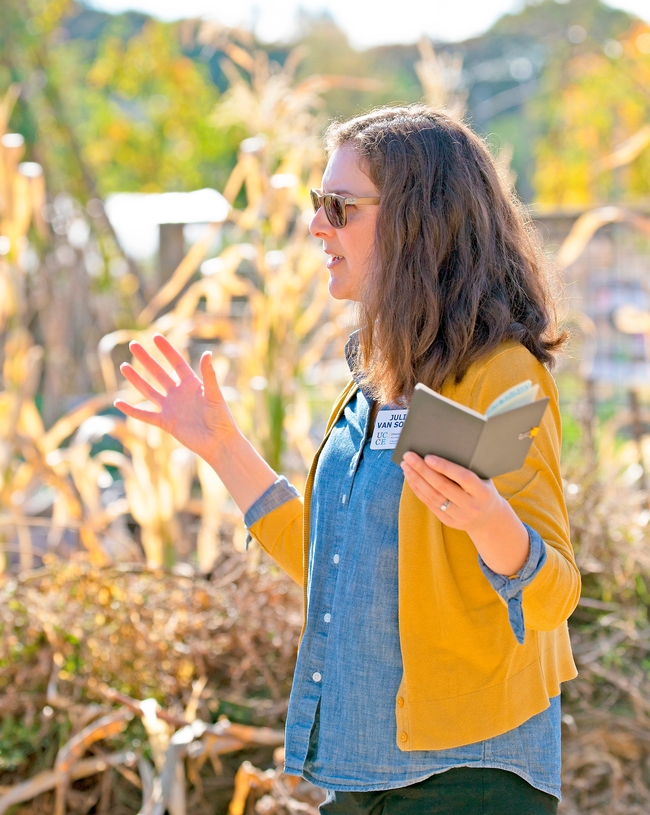
After the wildfires in 2017, Van Soelen Kim and Enright launched a citizen science project with community partners to assess produce safety. Within days of the fire, volunteers collected 200 samples of leafy greens from school, backyard and community gardens. With funding from UC ANR and the Bay Area Air Quality Management District, they expanded testing to soil and partnered with UC Davis researchers to test eggs laid by backyard poultry, and published guidance for produce safety after urban wildfire.
After the Kincade Fire, when growers and gardeners asked if produce grown outdoors was safe to eat, Enright said UCCE Sonoma County could tell them, based on local research, it was safe to eat if consumers removed outer leaves and washed the produce and that the health benefits of eating fresh produce outweigh any trace contamination.
UCCE has been leading a coalition of community partners and government organizations to educate the community on reducing food waste and increasing food recovery. When PG&E announces public safety power shutoffs, they promote composting food that can't be eaten so it doesn't end up in a landfill.
“This kind of service in communities is not as well-known about UC as the campuses,” Humiston commented to the regent.
Across the street from Bayer Farm, Diego Mariscal, 4-H program assistant, has been collaborating with Sheppard Elementary School. It is one of several schools in the county providing 4-H afterschool clubs and other 4-H programs designed to nurture the next generation of Latino leaders. Last spring, Mariscal worked with families to build a 4-H soccer league for elementary school children. Parents, college and high school students were trained by 4-H to teach children teamwork, soccer skills and healthy eating habits. More than 200 new underserved youth participated in 4-H programs in Sonoma County during the 2018-2019 year.
A few of the soccer players, proudly wearing their green 4-H soccer uniforms, told the group what they liked about 4-H. 4-H All Star Corrianna E., who participates in the 4-H teen program, shared her experience in 4-H and expressed gratitude to the program for helping her overcome her shyness to become a strong public speaker. Corrianna's mother, Naomi Edwards, also shared her experience as 4-H Council President for Sonoma County.
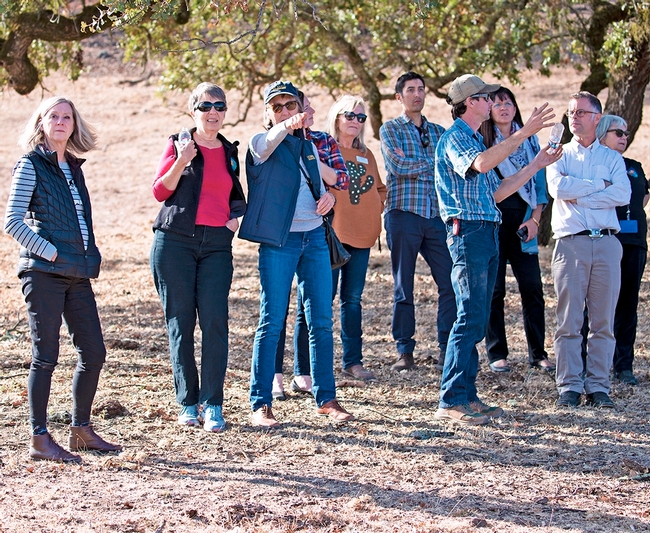
“You want to know what's a good cultural practice? Rhonda Smith has answers backed up by hard science,” Gorman said of the UCCE viticulture advisor. 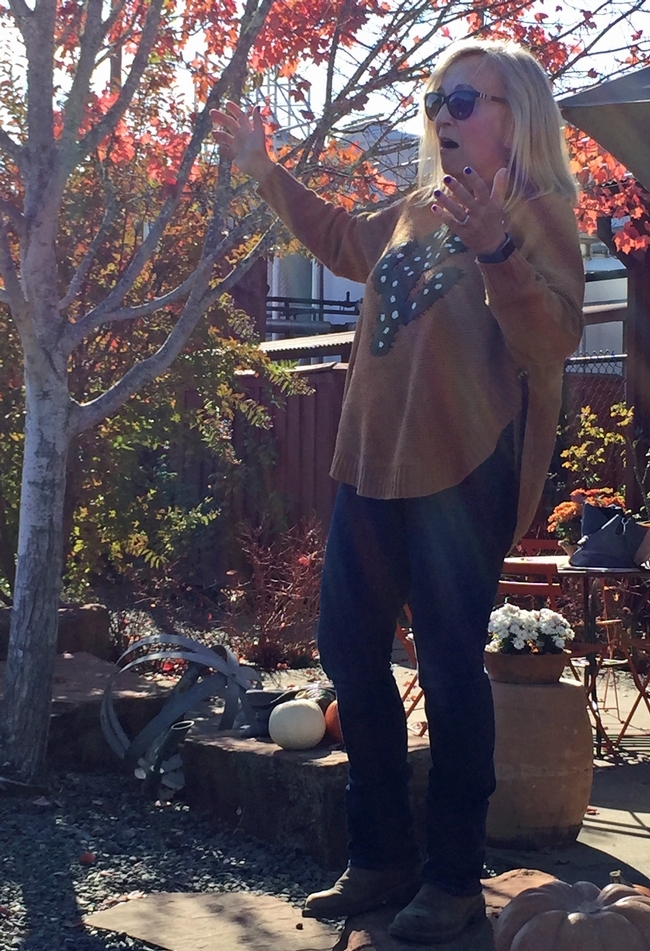
When new landowners ask Gorman for advice, he refers them to Steven Swain, UCCE environmental horticulture advisor, who advises small parcel land managers in Sonoma County on managing the land for fire and wildlife. “Without UCCE, where would they turn?” Gorman asked, adding that people from private companies may have recommendations that may not be in best interest of the land.
Larson introduced new UC IPM advisor Cindy Kron, who succeeds recent retiree Lucia Varela. Kron is launching an IR-4 project to study pesticides for olives, which isn't a big enough market to interest private investment in research. She's also monitoring pears for brown marmorated stink bug because early detection is key to controlling the pest. Spotted lanternfly isn't in California yet, but grapes are among its favorite hosts so Kron is working with UC Master Gardener volunteers and other community members to watch for the exotic pest.
The Kincade Fire destroyed fences and scorched the rangeland at Stuhlmuller Vineyards, forcing Gorman to sell the cattle. He showed the group where the fire failed to advance at the fire break created by the lush vineyards. As a result of the Kincade Fire, Gorman wasn't able to sell his petite verdot, chardonnay and cabernet grapes to wineries. To prove to the insurance company that smoke damaged the crop, his crew picked 30 tons of grapes for testing.
During and after the devastating fires in the North Bay, Larson, who is also a UCCE livestock and range management advisor, assisted livestock owners to gain access to their burned properties; this ensured their animals got food and water. She also organized resource meetings for landowners affected by fires, helping them apply for funding from government agencies and insurance companies for animal, forage and facility losses.
Larson also said her new grazing database Match.Graze has been well-received by ranchers and landowners in Sonoma and Marin counties who want to use grazing to reduce fire fuels. Land managers and grazers can sign up at ucanr.edu/matchgraze to hire sheep, goats, cattle and horses to manage fire fuels.
The regent tours in Sonoma Country and Fresno County were coordinated by Anne Megaro, government and community relations director. She is planning future tours for regents at UC South Coast Research and Extension Center and other locations in the spring.
